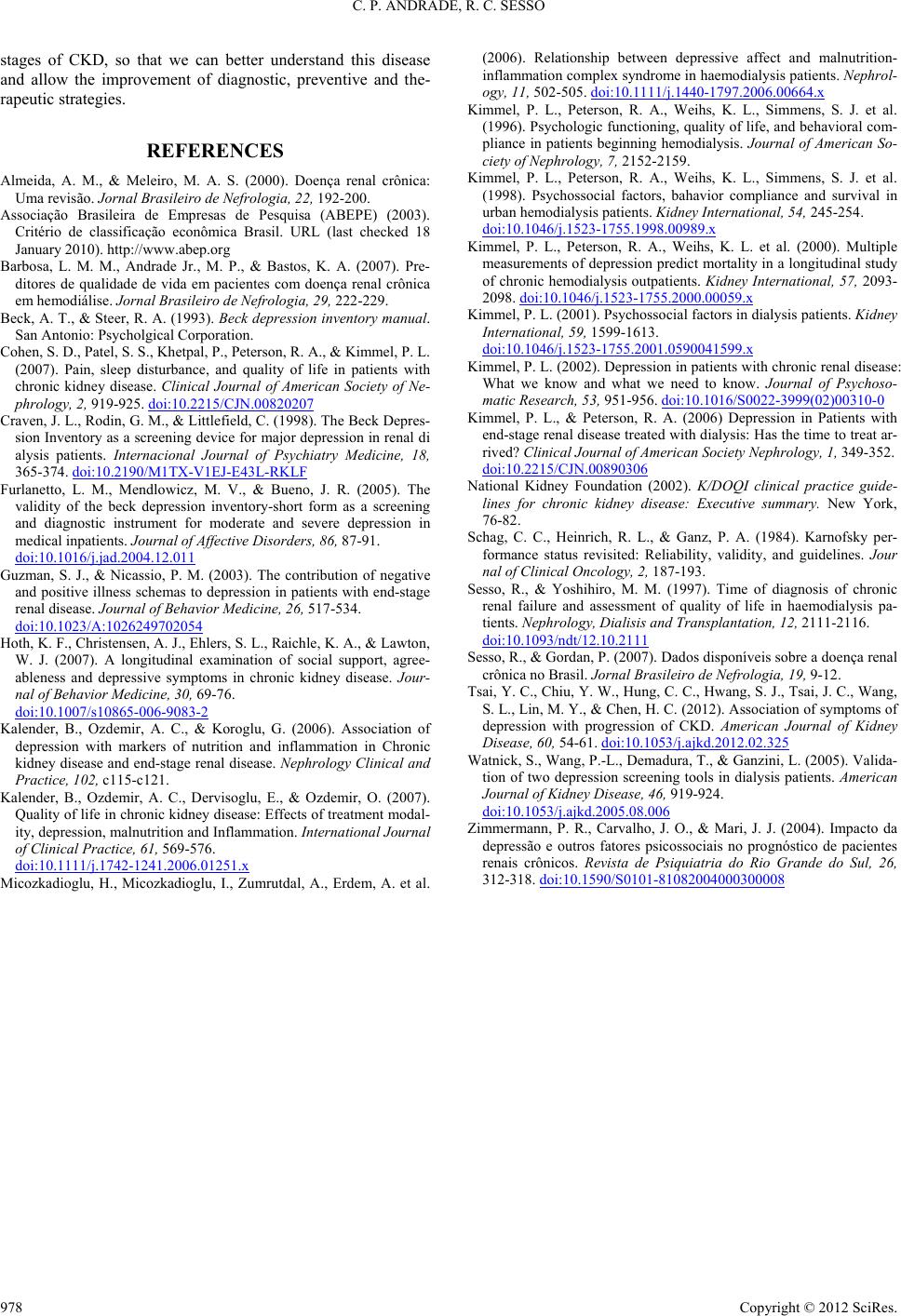
C. P. ANDRADE, R. C. SESSO
stages of CKD, so that we can better understand this disease
and allow the improvement of diagnostic, preventive and the-
rapeutic strategies.
REFERENCES
Almeida, A. M., & Meleiro, M. A. S. (2000). Doença renal crônica:
Uma revisão. Jornal Brasileiro de Nefrologia, 22, 192-200.
Associação Brasileira de Empresas de Pesquisa (ABEPE) (2003).
Critério de classificação econômica Brasil. URL (last checked 18
January 2010). http://www.abep.org
Barbosa, L. M. M., Andrade Jr., M. P., & Bastos, K. A. (2007). Pre-
ditores de qualidade de vida em pacientes com doença renal crônica
em hemodiálise. Jornal Brasileiro de Nefrologia, 29, 222-229.
Beck, A. T., & Steer, R. A. (1993). Beck depression inventory manual.
San Antonio: Psycholgical Corporation.
Cohen, S. D., Patel, S. S., Khetpal, P., Peterson, R. A., & Kimmel, P. L.
(2007). Pain, sleep disturbance, and quality of life in patients with
chronic kidney disease. Clinical Journal of American Society of Ne-
phrology, 2, 919-925. doi:10.2215/CJN.00820207
Craven, J. L., Rodin, G. M., & Littlefield, C. (1998). The Beck Depres-
sion Inventory as a screening device for major depression in renal di
alysis patients. Internacional Journal of Psychiatry Medicine, 18,
365-374. doi:10.2190/M1TX-V1EJ-E43L-RKLF
Furlanetto, L. M., Mendlowicz, M. V., & Bueno, J. R. (2005). The
validity of the beck depression inventory-short form as a screening
and diagnostic instrument for moderate and severe depression in
medical inpatients. Journal of Affective Disorders, 86, 87-91.
doi:10.1016/j.jad.2004.12.011
Guzman, S. J., & Nicassio, P. M. (2003). The contribution of negative
and positive illness schemas to depression in patients with end-stage
renal disease. Journal of Behavior Medicine, 26, 517-534.
doi:10.1023/A:1026249702054
Hoth, K. F., Christensen, A. J., Ehlers, S. L., Raichle, K. A., & Lawton,
W. J. (2007). A longitudinal examination of social support, agree-
ableness and depressive symptoms in chronic kidney disease. Jour-
nal of Behavior Medicine, 30, 69-76.
doi:10.1007/s10865-006-9083-2
Kalender, B., Ozdemir, A. C., & Koroglu, G. (2006). Association of
depression with markers of nutrition and inflammation in Chronic
kidney disease and end-stage renal disease. Nephrology Clinical and
Practice, 102, c115-c121.
Kalender, B., Ozdemir, A. C., Dervisoglu, E., & Ozdemir, O. (2007).
Quality of life in chronic kidney disease: Effects of treatment modal-
ity, depression, malnutrition and Inflammation. International Journal
of Clinical Practice, 61, 569-576.
doi:10.1111/j.1742-1241.2006.01251.x
Micozkadioglu, H., Micozkadioglu, I., Zumrutdal, A., Erdem, A. et al.
(2006). Relationship between depressive affect and malnutrition-
inflammation complex syndrome in haemodialysis patients. Nephrol-
ogy, 11, 502-505. doi:10.1111/j.1440-1797.2006.00664.x
Kimmel, P. L., Peterson, R. A., Weihs, K. L., Simmens, S. J. et al.
(1996). Psychologic functioning, quality of life, and behavioral com-
pliance in patients beginning hemodialysis. Journal of American So-
ciety of Nephrology, 7, 2152-2159.
Kimmel, P. L., Peterson, R. A., Weihs, K. L., Simmens, S. J. et al.
(1998). Psychossocial factors, bahavior compliance and survival in
urban hemodialysis patients. Kidney International, 54, 245-254.
doi:10.1046/j.1523-1755.1998.00989.x
Kimmel, P. L., Peterson, R. A., Weihs, K. L. et al. (2000). Multiple
measurements of depression predict mortality in a longitudinal study
of chronic hemodialysis outpatients. Kidney International, 57, 2093-
2098. doi:10.1046/j.1523-1755.2000.00059.x
Kimmel, P. L. (2001). Psychossocial factors in dialysis patients. Kidney
International, 59, 1599-1613.
doi:10.1046/j.1523-1755.2001.0590041599.x
Kimmel, P. L. (2002). Depression in patients with chronic renal disease:
What we know and what we need to know. Journal of Psychoso-
matic Research, 53, 951-956. doi:10.1016/S0022-3999(02)00310-0
Kimmel, P. L., & Peterson, R. A. (2006) Depression in Patients with
end-stage renal disease treated with dialysis: Has the time to treat ar-
rived? Clinical Journal of American Society Nephrology, 1, 349-352.
doi:10.2215/CJN.00890306
National Kidney Foundation (2002). K/DOQI clinical practice guide-
lines for chronic kidney disease: Executive summary. New York,
76-82.
Schag, C. C., Heinrich, R. L., & Ganz, P. A. (1984). Karnofsky per-
formance status revisited: Reliability, validity, and guidelines. Jour
nal of Clinical Oncology, 2, 187-193.
Sesso, R., & Yoshihiro, M. M. (1997). Time of diagnosis of chronic
renal failure and assessment of quality of life in haemodialysis pa-
tients. Nephrology, Dialisis and Transplantation, 12, 2111-2116.
doi:10.1093/ndt/12.10.2111
Sesso, R., & Gordan, P. (2007). Dados disponíveis sobre a doença renal
crônica no Brasil. Jornal Brasileiro de Nefrologia, 19, 9-12.
Tsai, Y. C., Chiu, Y. W., Hung, C. C., Hwang, S. J., Tsai, J. C., Wang,
S. L., Lin, M. Y., & Chen, H. C. (2012). Association of symptoms of
depression with progression of CKD. American Journal of Kidney
Disease, 60, 54-61. doi:10.1053/j.ajkd.2012.02.325
Watnick, S., Wang, P.-L., Demadura, T., & Ganzini, L. (2005). Valida-
tion of two depression screening tools in dialysis patients. American
Journal of Kidney Disease, 46, 919-924.
doi:10.1053/j.ajkd.2005.08.006
Zimmermann, P. R., Carvalho, J. O., & Mari, J. J. (2004). Impacto da
depressão e outros fatores psicossociais no prognóstico de pacientes
renais crônicos. Revista de Psiquiatria do Rio Grande do Sul, 26,
312-318. doi:10.1590/S0101-81082004000300008
Copyright © 2012 SciRes.
978